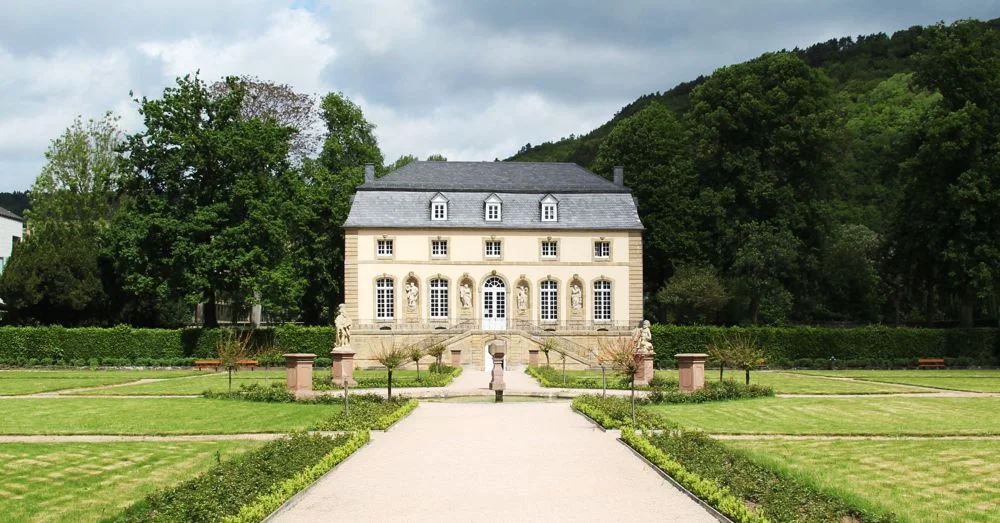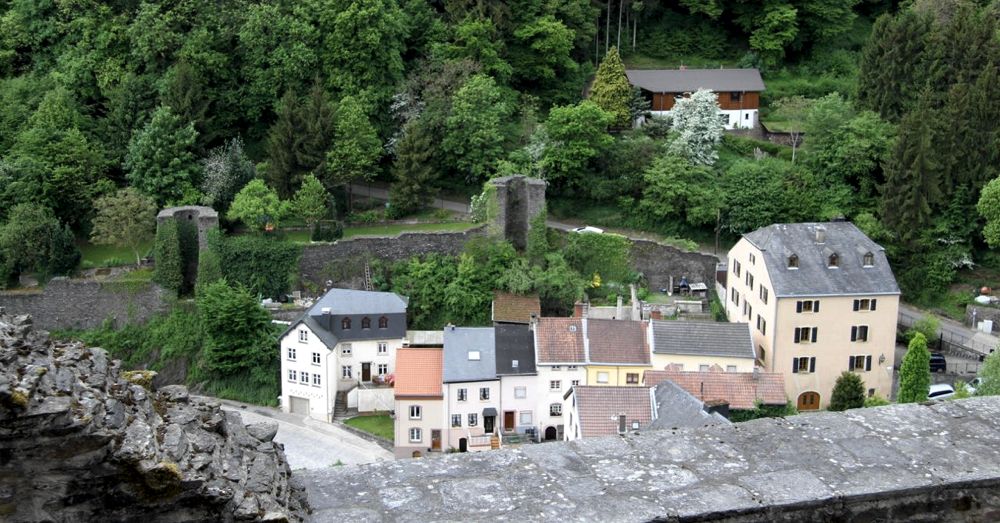Tuesday, 19-05-2015. Day 272.
Churches, Castles, and War
After touring Luxembourg City the previous day, we dedicated this day to exploring the rest of Luxembourg ... and a little bit of Belgium.
The Ancestral Homeland
We spent the first part of the day driving through the picturesque Luxembourg countryside looking at notable spots in the family history. Our family goes back many generations here, and it was really interesting to see where our ancestors lived, loved, and died.
EchTernach
When we’d finished with the ancestral tour, we found ourselves very close to Echternach, a small Luxembourg town on the Luxembourg-Germany border, so we stopped in for a quick stroll through the oldest town in Luxembourg.
The ancient city of Echternach.
One of the biggest draws in Echternach is the Saint Willibrord Basilica, a neo-Gothic church that dates back to 1016, when it was built on the top of the site of a previous church (this seems to be a recurring theme in many cities we visit).
It was damaged heavily during the French Revolution and, after being used as a china factory for a little while, it was restored to a church in 1861. It was again damaged in 1944 during the Battle of the Bulge — which we will learn more about a little later.
Tomb of Saint Willibrord
Saint Willibrord, the patron saint of Luxembourg, is best known around these parts for bringing Christianity to Luxembourg from Ireland in the late 600s and setting up the Benedictine monastery in Echternach in 698. In the crypt below the church, his final resting place, the Tomb of Saint Willibrord, is kept safely behind glass.
Orangerie, Echternach
As we left the church behind, we walked past the Orangerie. I'‘m not sure exactly what it is, but if the plaque on the front gate is to be believed, it was at one time some sort of shelter to help keep exotic plants warm during the winter months.
After we walked back through the Echternach town square, we got back into our cars and drove into Germany for just a few minutes before crossing back into Luxembourg and making our way to Vianden Castle, a proper medieval castle dating back to the 10th century.
Vianden Castle
Vianden Castle
Vianden Castle has a long history as the seat of power for the Counts of Vianden, at least until the 16th century when it fell out of favor and into disrepair. At one point it was sold by King William I of the Netherlands to an enterprising gent who started to sell it off one piece at a time, but public outcry about this was so great the King bought it back at a loss.
In the years since, many different attempts were made to restore it, but it seemed that each effort was met with some sort of roadblock — like the heavy fighting of two World Wars in the region. Now, however, it’s owned by the state and has been restored to its former Gothic glory.
Catapult ammo. Note: they were hollow.
Inside the castle there are displays of period arms and armor, paintings and tapestries, and a few different dioramas of what life may have been like back when the Counts of Vianden lived here. Like the Palazzo Ducale in Urbino, Vianden Castle sits high (1,000 feet up) on a hill overlooking the town of Vianden below. From the parapets, you really get a good view of the small, walled city beneath you.
Looking out from Vianden Castle
After we left the castle, we drove all the way across Luxembourg and into Bastogne, Belgium to visit the excellent Bastogne War Museum.
Bastogne War Museum
The Bastogne War Museum not very fancy on the outside, but inside, it’s a really fantastic museum experience. In fact, it’s probably the best museum we’ve visited so far on our journey.
Bostogne War Museum
Bastogne was the site of the Battle of the Bastogne (no surprise there), which took place during the Battle of the Bulge near the end World War II. In this battle, a small group of American troops, surrounded by German forces, held off the Nazi war machine to keep the Germans from gaining control of the strategically desirable town.
The museum is set up to tell the chronological story of the Battle of Bastogne. Upon entering the museum, everyone is given a headset, which, unlike most museum headsets, is actually not uncomfortable to wear. And what’s great about this headset is that as you make your way through the museum, it automatically plays an appropriate part of the story from one of the four narrators. Philippe Jarbinet, artist and author of Airborne 44, has contributed artwork throughout the museum, which helps to make the experience a lot more personal.
At three points along the museum’s story path, you enter elaborate set pieces — the Allied War Room, a winter forest in the Ardennes, and a Bastogne café.
Allied war room interactive set.
These sets offered a great immersive experience — for example, the temperature in the Ardennes forest room dropped as the story unfolded. The café set, which took place during a severe bombing, was really fantastic.
And, lastly, the small restaurant that’s attached to the museum is really great and offers an excellent selection of Belgian beers. All in all, it’s a museum that's definitely worth visiting.
Mardasson War Memorial
Before leaving, we visited the star-shaped Mardasson Memorial (also called the American Liberators Monument), just across the street from the War Museum. This large structure was built to honor all the American soldiers who were wounded or killed in the Battle of the Bulge. The name of each state is inscribed on the top edge of the memorial and the insignias of the battalions that helped liberate the town are displayed in the center.
Looking out from the Mardasson War Memorial.
After we left the museum, we headed back to Luxembourg City and had a nice, leisurely dinner with our Luxembourg family. It was quite delightful, and we were sad to be leaving in the morning. But, Paris was calling ...
Header image: Vianden Castle

Tom Fassbender is a writer of things with a strong adventurous streak. He also drinks coffee.













